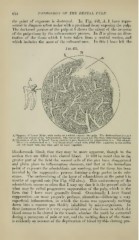Page 844 - My FlipBook
P. 844
854 PATHOLOGY OF THE DENTAL PULP.
the point of exposure is destroyed. In Fig. 451, A, I liave repre-
sented in diagram a first molar with a proximal decay exposing the pulp.
The darkened portion of the pulp at b shows the extent of the invasion
of the pulp-tissue by the inflannnatory process. In B is given an illus-
tration of the tissue which I have taken from a central section, and
which includes the most of the inflamed area. In this I have left the
Fig. 451.
A, Diagram of Lower Molar, with caries at a which exposes the pulp. The darkened portion at 6
shows the extent of the iiiflaiiiniation. The rest of the organ was free from inflammatory change.
£, Illustration of the Inflamed Tissue, showing a part destroyed hy suppuration at a. The odonto-
blasts are uuderniiued at (*. The blood-vessels which were filled with blood-clot in the section
are left blank here, that they may be more apparent.
blood-vessels blank, that they may be more ap])arent, though in the
section they are filled with clotted blood. It will be noted that in the
greater part of the field the normal cells of the part have disappeared
and given place to inflammatory elements, and that at the immediate
point of exposure the odontoblasts are wanting, and the tissue has been
invaded by the suppurative process forming a deep pocket in its sub-
stance. The undermining of the layer of odontoblasts at the point b is
worthy of especial note (See Fig. 452 also.). This undermining of the
odontoblasts occurs so often that I may say that it is the general rule in
what may be called progressive suppuration of the pulp, which is the
form that I have most generally found. Occasionally I have found
suppuration—or more properly, perhaps, ulceration—folloSving a very
superficial inflammation, in Avhich the tissue was apparently melting
down into a sanious pus thickly inhabited by micro-organisms. In
thesis instances there is a very superficial area of the tissue in which the
blood seems to be clotted in the vessels, whether the tooth be extracted
during a paroxysm of pain or not, and the melting down of the tissue
is evidently on account of the deprivation of blood by this clotting pro-


